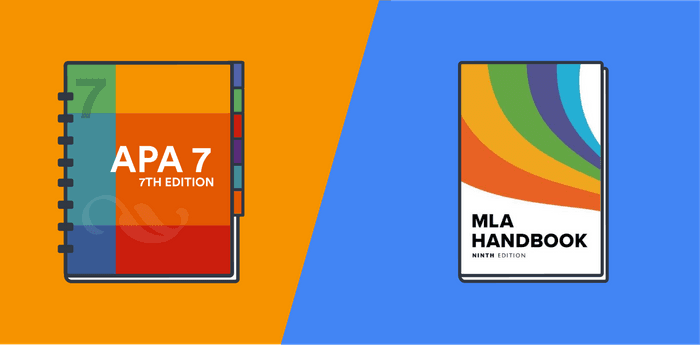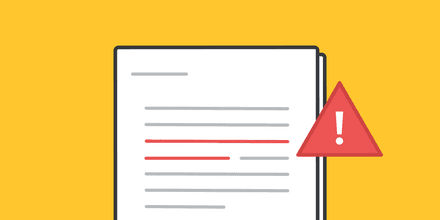
APA and MLA are two of the most common citation styles. But, what’s the difference between APA and MLA format? In this post, we discuss the differences between APA and MLA. We cover when to use these styles and provide examples of correct APA and MLA citations.
What is APA?
APA style is a citation style that is most commonly used in the social sciences, but also in education, business, and some science fields. APA stands for American Psychological Association.
Essentially, APA style is a set of rules for formatting citations, title pages, headers, and other aspects of research papers.
What is MLA?
MLA style is the primary citation style for humanities fields like literature. It was developed by the Modern Language Association of America, an association of scholars and teachers of language and literature.
Like APA, MLA style includes rules for how to format citations and how to structure research papers.
What are the differences between APA and MLA?
Both APA and MLA style require two distinct types of citations:
- in-text citations
- full bibliographic references in a section at the end of the paper
APA and MLA citations also have similar components:
- Book citations contain the author’s name, the title of the book, the publisher, and the publication date.
- Journal article citations contain the author’s name, the title of the work, and the date, but also include the title of the journal, the volume and issue number of the journal, and the page range. Citations for online journal articles also include a DOI.
- Website citations feature the author’s name (if one is available), the title of the website, the date that is was published or accessed, and the URL.
The main differences between APA and MLA are in how they format and structure these elements.
In-text citations
APA and MLA style both utilize parenthetical citations for in-text citations. However, there are key differences between the two:
- ALA parenthetical citations include the author’s last name and the year of publication (Smith, 2020). When a specific page number is cited, the citation also includes p. and the number (Smith, 2020, p. 4).
- MLA parenthetical citations mainly include the author’s last name and a page number, without a comma between the elements (Smith 25).
Papers in APA style may also utilize narrative citations. Here are a few examples of APA narrative citations:
Rode (2012) claims that productive activities have been part of human civilization since ancient times.
In some cases, author and date might both appear in the narrative. In this case, no parentheses are needed:
In 2012, Rode wrote about the productive activities...
If you cite multiple works parenthetically, place the citations in alphabetical order, separating them with semicolons:
(Adams et al., 2019; Shumway & Shulman, 2015; Westinghouse, 2017)
If multiple sources are cited within a sentence, they can appear in any order:
Suliman (2018), Gutiérrez (2012, 2017), and Medina and Reyes (2019) examined...
Bibliographic references
MLA prefers the label “Works Cited” for the bibliography at the end of the paper. This list includes full bibliographic references for all of the cited texts. APA calls this list “References,” and includes both works that were cited and those that were consulted. Both styles alphabetize entries by the first author’s last name.
Additionally, APA and MLA bibliographies differ in how they structure individual entries. The primary differences occur in:
- Author name: While both styles invert the regular order of names (i.e. put the last name first), APA abbreviates the author’s first name and only uses the first letter, followed by a period (Smith, J.). MLA uses both the last name and first name of an author (Smith, Jane).
- Date placement: APA requires the publication date to be in parentheses, following the author’s name: Smith, J. (2020). In MLA, the publication date goes at the very end for books, or after the volume and issue numbers for journals.
- Capitalization: In APA style, you only need to capitalize the first word of a title, the first word following a colon, and any proper nouns. MLA requires you to capitalize all of the words in a title, except for articles.
- Volume and issue numbers for journal articles: Both APA and MLA place the volume and issue numbers of journals after the journal title; however, they format this information differently. APA italicizes the volume number and places it directly against the issue number, which is put in parentheses: 6(3). MLA style uses the abbreviations, vol. (volume) and no. (number), and places a comma between them: Journal of Pedagogy, vol. 6, no. 3.
APA examples and resources
Here are some examples of full bibliographic citations in APA style:
References
Atske, S. (2021, April 7). Social media use in 2021. Pewresearch.Org. https://www.pewresearch.org/internet/2021/04/07/social-media-use-in-2021/
Eskritt, M., Fraser, B., & Bosacki, S. (2021). Did you just lie to me? Deception detection in face to face versus computer mediated communication. The Journal of Social Psychology, 1–14.
Fuchs, C. (2021). Social Media: A Critical Introduction (3rd ed.). SAGE Publications.
Resources
Visit these resources to learn more about APA citations and formatting:
APA citation guide (7th edition)
The ultimate guide to citing in APA
APA title page: format and templates
MLA examples and resources
Here are some examples of full bibliographic citations in MLA style:
Works Cited
Edwards, Michael. “The Lost Library of Anne Conway.” The Seventeenth Century, vol. 36, no. 1, 2021, pp. 119–147.
Farr, Jason S. Novel Bodies: Disability and Sexuality in Eighteenth-Century British Literature. Rutgers University Press, 2019.
Wall, Wendy. “The Pulter Project.” Northwestern.Edu, https://pulterproject.northwestern.edu/. Accessed 18 Aug. 2021.
Resources
Visit these resources to learn more about MLA citations and formatting:
MLA citation guide (9th edition)
The ultimate guide to citing in MLA
MLA title page: format and templates
Frequently Asked Questions about what is the difference between APA and MLA format
🌏 What is the main difference between APA and MLA format?
The main differences between APA and MLA format are found in the bibliography. APA style uses a reference list that includes any works cited or consulted; MLA uses a works cited list that only contains texts that were cited in the paper. Also, there are differences in how each style handles key pieces of bibliographic information like titles and names.
🌵 How do you know if you should use APA or MLA?
If you need to create citations for an assignment, you can ask your instructor which style to use. APA is most commonly used in the social sciences, while MLA is preferred in humanities disciplines.
🍖 What is APA used for?
APA style is used to create in-text citations and bibliographic references for the social sciences and other disciplines.
🎿 What is MLA used for?
MLA style is used to create in-text citations and works cited entries for some humanities fields.
💛 What are the similarities between APA and MLA?
Both APA and MLA aim to provide guidance on how to create accurate citations and bibliographies. Using these styles correctly lends credibility to your research and helps you to avoid plagiarism.


